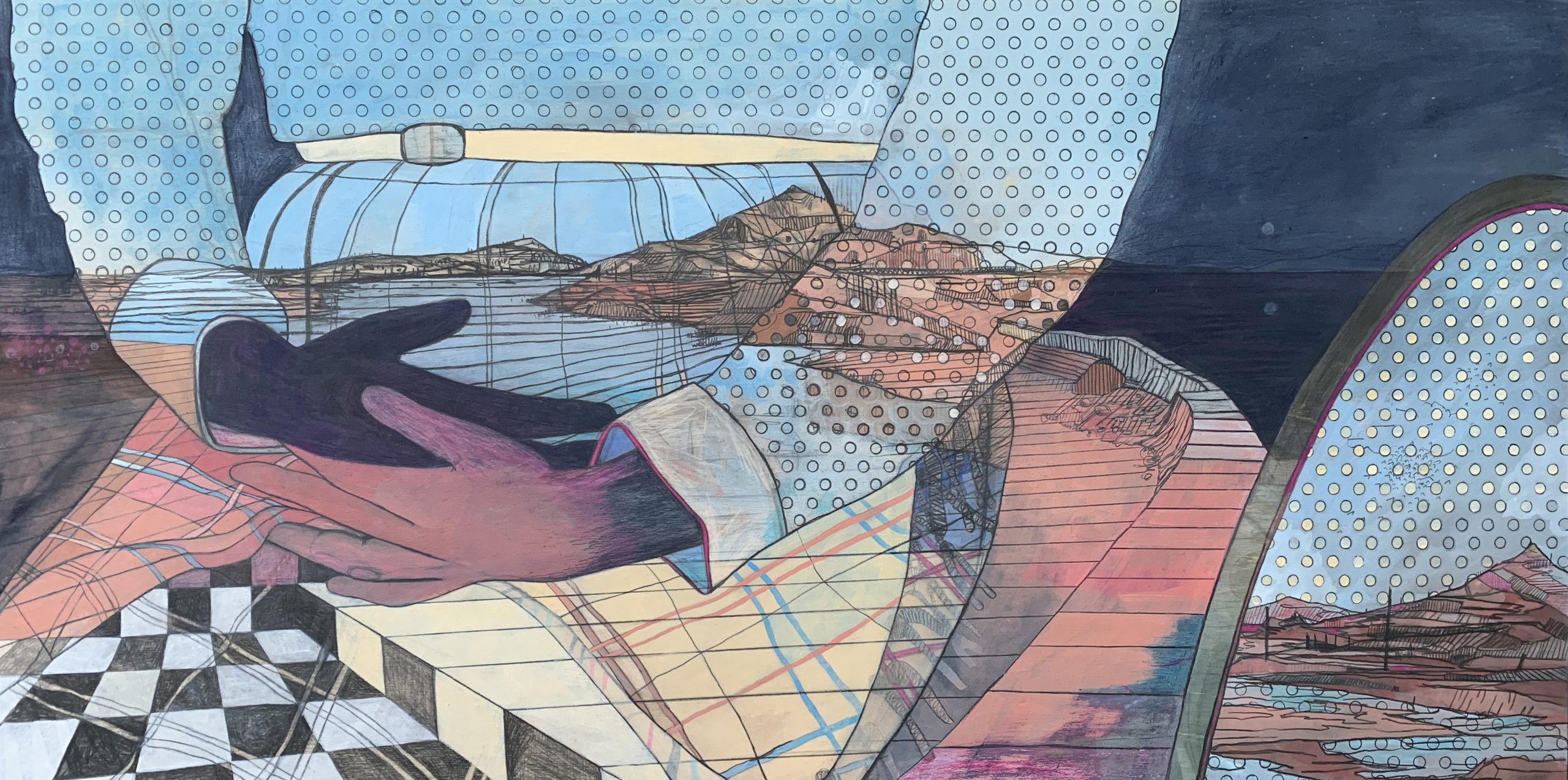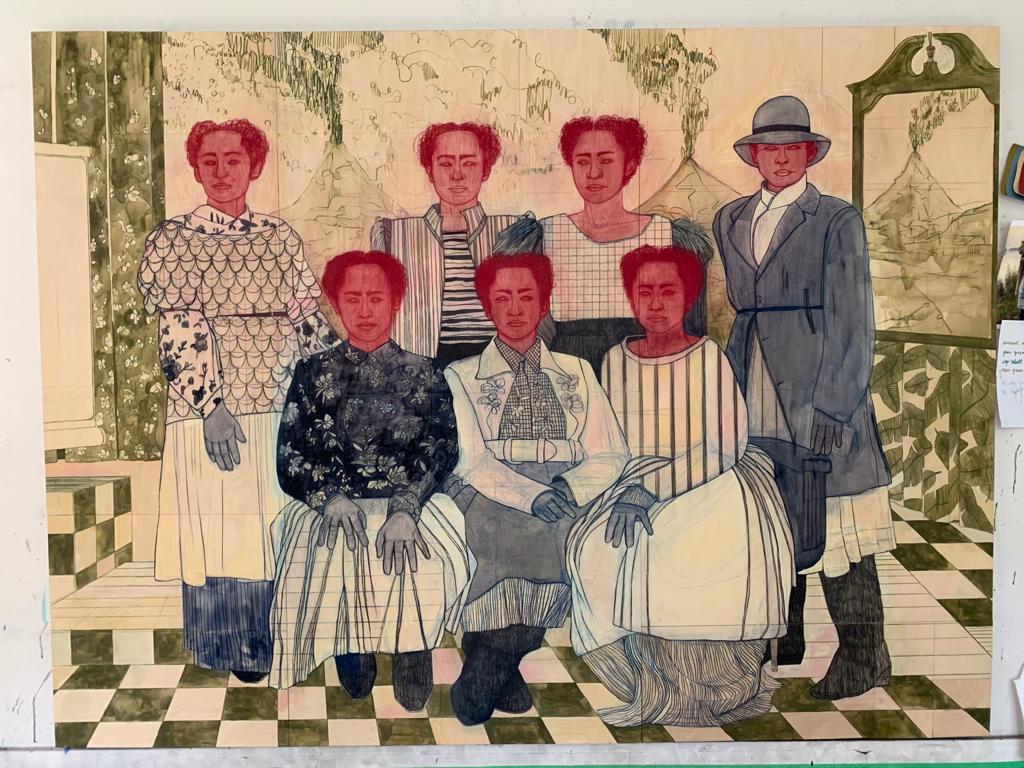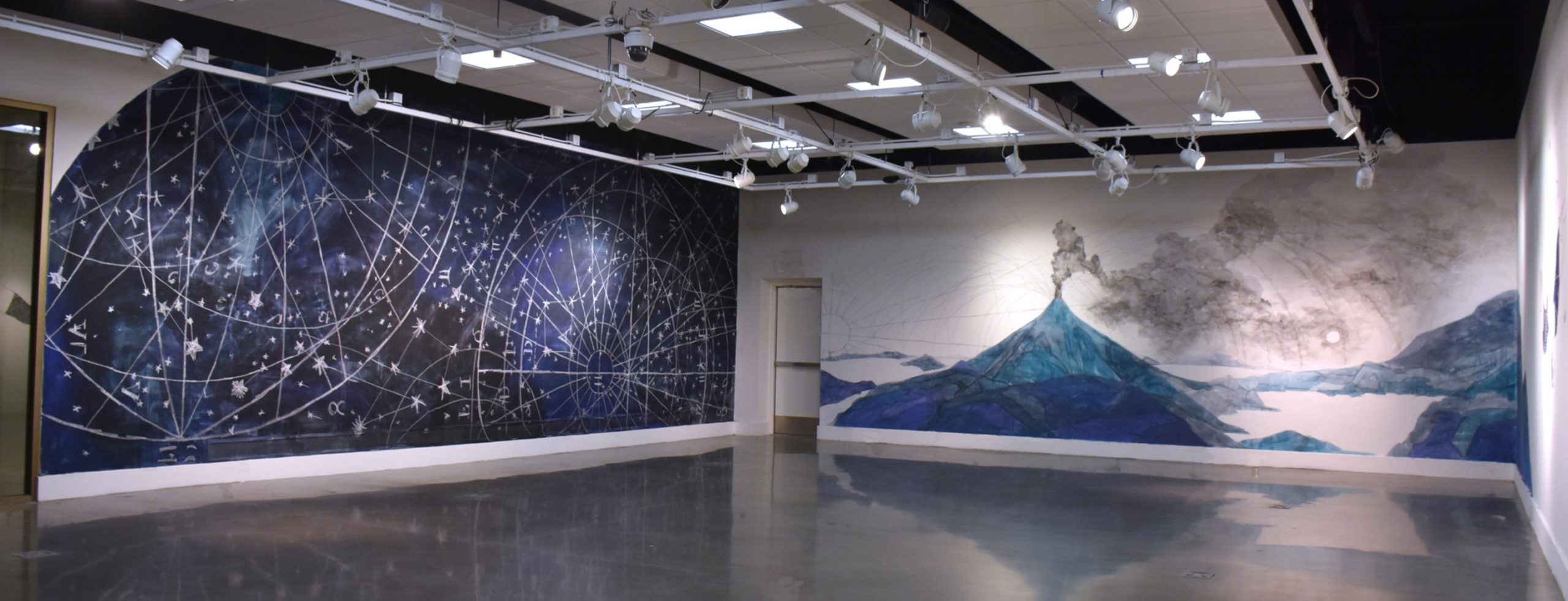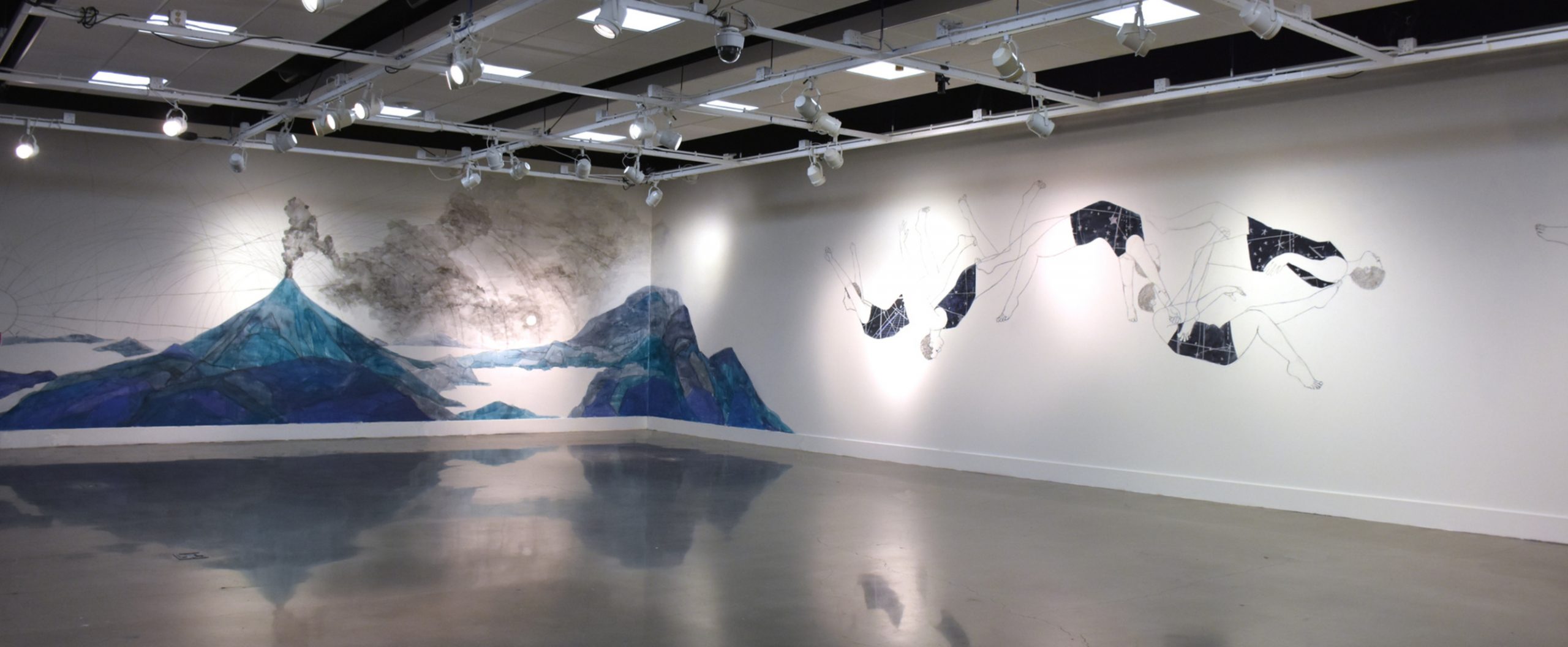During a virtual walk through her new solo exhibition, BATTLECRY, Pamela Phatsimo Sunstrum hinted at her volcanoes in conversation with curator Elvira Dyangani Ose. Speaking to her work Trooper, she described the volcano shimmering on the horizon as both “a physical earthly sensibility” that suggests the flow of the unseen and unpredictable, as well as a great metaphor for going inward, into both self and “the bellybutton of the earth”. While she spoke freely about drawing on cosmological knowledges, ancestral archives and the planes of physics, there was a certain shyness about the way in which she spoke to and about her volcanoes. I asked her about the manner in which she uses features, like these volcanoes, to explore or develop an awareness of the environment through her declared interest in geology. Her answer was an enthusiastic eruption of references ranging from reading Jules Vernes’s 1871 classic Journey to the Centre of the Earth, to going on holiday to the Pilanesberg mountains as a child and being struck by simulations of earthquakes and volcanoes at Sun City—itself a bizarre civilisation simulation.
The Bridge of Time—a ride at Sun City’s Valley of the Waves—erupts every hour in a theatrical display of mock-volcano vibrations, rumbling sounds and smoke. The luxury resort and casino was opened in 1979 in what was then the Bantustan of Bophuthatswana, declared an independent state by the apartheid government, however, unrecognised as such by any other country. This meant that the resort could legally provide entertainments which were banned in South Africa (like gambling) and also accommodate international artists like Elton John and and Cher, despite the cultural boycott in opposition to apartheid. The Valley of the Waves homepage still states:
In the heart of this ancient volcano, according to the legend, a great civilisation arose. The peace-loving nomads from the north settled in this lush green valley, where they built their spectacular Palace, surrounded by abundantly flowing waters and beautiful gardens. After an earthquake destroyed their home, the people fled and eventually, the Palace and its city became completely overgrown. Centuries later, a modern explorer stumbled upon this Lost City. The Palace was restored to its former glory, and re-opened in 1992 as part of the amazing Lost City development at Sun City.

Trooper, 2020.
Despite this generous backstory, there was still something bashful about Phatsimo Sunstrum’s description of the volcanoes as portals – as ways to access “the core realms” of both the primordial and apocalyptic landscapes explored in her paintings. This reticence, in fact mirrors the visual presence of the volcanoes tucked away as they are, with the human figures dominating the scene—as we do. Responding to another question, Pamela expressed a need to “situate human interventions in landscape”, an impulse which announces itself more clearly in another work titled Sleight. Here, she evokes “the far away view of an idyllic landscape that is in of itself kind of a trap”, entangling it with figure, landscape and layering to suggest more complicated and interrelated narratives. The volcanoes are at ease in this one, but more pronounced. Not so in The Seven where they billow in the background. Pouring over these images, I felt the volcano as leitmotif snagging in my mind and did not know how to fully explore this. I mean… not in the sense of exploring her volcanoes in technical art terms, but in the broader sense of thinking with volcanoes as means to communing with geological consciousness. Volcanoes are interesting not just as a meeting of geology and ecology; flip sides of the same terra coin, but they also present as layered fire cones of political thought. For example, volcanoes feature prominently in Edouard Glissant’s efforts to use ecological activism as a conceptual bridge between his poetics and his politics. It wouldn’t be difficult to similarly use Sunstrum’s volcanoes as a bridge to wax lyrical about the precepts of representation (drawing perspective through complex constructions) or the basic principles of Modernism (the image of the volcano being its own thing and not merely a representation). But for some reason, thinking about them as portals in the true sense of seething black holes of the natural world, is difficult.
For one, these ancient rocks of fire remain difficult to measure by modern science. Similar to the Richter scale, the Volcanic Explosivity Index (VEI) is a relative scale that enables explosive volcanic eruptions to be compared with one another. However, measuring the strength of a volcanic eruption is more challenging than measuring ground motion with an instrument because volcanic eruptions produce different types of products, have different durations and develop in different ways. Additionally, some eruptions are explosive (rock materials blasted from the vent) while others are effusive (molten rock flowing from the vent). They also retain creation memories; embodying a primordial spiritual geology. Perceiving volcanoes as portals to both the centre of the earth as well as portals to a more generalised cosmic formlessness, volcanic archaeologist Karen Holmberg suggests that, “the volcano is philosophically an artist, simply by existing as both a geological void and a physical form capable of emitting lava, gas, ash, and steam that can be seen and recorded by the human eye”. What does it mean to be a geologic void—sporadically spurting molten anger? Is it presumptuous to interpret the work of the volcano as a rage against the imbricated histories of colonialism, capitalism and climate crisis? In Into the Inferno (2016), Chief Mael Moses of Ambrym; a volcanic island in the archipelago of Vanuatu, explains lava as an expression of ancestor anger, describing the fire as “burning through the spirits” living in the crater. There is something calming about his take on volcanoes as the planetary endgame, prophesying that a time will come when the volcanoes of the world will align—erupting in tandem and washing us in regenerative fire. The documentary headline, “the fury of nature exposes us all” is apt.

Sleight, 2020.
Regarding exposition, artist James Turrell describes “the eye as the most exposed part of the brain, as something that is already forming perception”. His work provides much to think about when it comes to the relationship between exposition, perception and volcanoes—he has been moulding, exposing; designing a privately owned volcanic crater for more than thirty years. Roden Crater, located in the Painted Desert region of Northern Arizona, is both a large-scale artwork created within a dormant volcanic cinder and a controlled environment for the experiencing and contemplation of light. Acquired in 1977, Turrell has magicked the crater into an observation site of tunnels and apertures to capture light directly from the sun during daylight hours, and the planets and stars at night. He explains, “I like to use light as a material. But my medium is really perception. I want you to sense yourself sensing. To see yourself seeing. To be aware of how you are forming the reality you see”. I see myself seeing Sunstrum’s volcanoes and fixating on them not just because they are a gorgeous feature in her paintings—which they are—but because I am aware of the reality that geologic thinking is really difficult, so I appreciate these volcanic cuties as discreet reminders to apply myself to thinking geologically. There is a fair amount of literature on humans struggling to make sense of geologic time, either conflating events widely separated by time or not grasping different rates of change or evolution. For this reason, it is useful to distinguish between geologic and deep time, because the two are often used interchangeably. Deep time means the staggering stretch of the pre-human past (more than 8000 years ago), while geologic time is the rough time scale used by geoscientists to tell time (millions of years being the most common unit of measurement).
The concept of time is notoriously elusive, however, despite the difficulty of the varied temporal spans, time is forever culturally relevant as evidenced by the proliferation of time-travel books and films. Thinking about Sunstrum’s volcanoes in these temporal terms and in tandem with her complex constellation of fantasy, science, mythology and theories about the universe is similarly rich terrain. I have also been cogitating on the title of this exhibition. Why BATTLECRY? I half wish I had asked her, and am half glad to dream about volcanic battlecries. Deborah Dixon and Daniel Beech write about knowledge-making within volcanology, in particular the crucial role of aesthetics and art in volcanic knowledges. Their work reveals how aesthetic (understood as embodied, sensuous encounters with Nature) and art (understood as imaginative visualisations of Nature) are inextricably part and parcel of the study of volcanoes. This reading of the intertwining of art and science is presented as a creative reservoir that has cut across scientific and art divides for decades. Today, ‘social volcanology’ denotes approaches to contemporary volcanism that address the ways in which volcanic impacts on human communities are culturally embedded; a branch of study that crosses disciplinary boundaries between the humanities, social sciences and geosciences. Can the same interdisciplinary nature be adopted when viewing, reading and writing about art? Are there mechanisms in place for communicating and critiquing environmental risk, education and debate in visual arts?

The Seven, 2020.
I am reminded of art historian Nomusa Makhubu’s interpretation of video artist Zina Saro-Wiwa’s food interventions as an opportunity to revisit the idea of entanglement. Describing the social possibilities that food engenders and the way that eating together can be seen as a situational art practice, Makhubu reveals the many ways that Saro-Wiwa’s work brings together forms of cultural, racial and class difference as a web of entanglements. What are the social possibilities provided by Sunstrum’s volcanoes—sneaked into her works like hidden-centre cupcakes? To me, they suggest the entanglement of her localised place-based practice and a more abstract approach to systems-thinking that taps into “the core realms” that she alluded to during her talk with Elvira Dyangani Ose. Makhubu draws on Sarah Nuttall’s description of entanglement as a “condition of being twisted together or entwined, involved with; it speaks of intimacy gained” and Achille Mbembe’s argument that the post-colony “encloses multiple durées made up of discontinuities, reversals, inertias and swings that overlay one another, interpenetrate one another”. Focusing on how Saro-Wiwa reveals food to elicit personal and collective historical narratives of colonial expansion, dispossession and cultural imperialism; Makhubu in-turn reveals how entanglement as a concept paves the way for thinking about “spatio-temporality, art practices and interventions where historical narratives collide, mingle or coalesce”. Spatio-temporality is critical in Sunstrum’s work and the volcanoes are just one aspect of her time and space bricolage. However, they require a wild scale and furthermore, contemplation of the abyss of geo-history is as dizzying as peering into an active volcano and this I suppose; is the battlecry bubbling at the bottom of these hot lava, molten rock and vapour fragments.
The artist’s call to arms by helping viewers to imagine concepts (like deep and geologic time) that are outside of the realm of human experience. Helping to abstract human context to think with angry rock formations. Helping to engage with art as a way of knowing—even when we really have no idea what is happening, deep down below the lithosphere. It is well established, recognised and theorised that art production is knowledge production by virtue of being a cognitive act. But the lines between art, science, and activism blur depending on the audience, and something needs to be said about the act of responding to the battlecry. As Turrell suggested, the real medium is perception so articulating our relationship to both the art and geological world demands cognisance of the interface of scientific research, cultural history and art practice. Here, the collaborative spirit of There are Mechanisms in Place (2020), a response to Sunstrum’s practice (and 2018 exhibition of the same name) recently published by Michaelis Gallery is instructional. Nkgopoleng Moloi cogently investigates the publication as a sacred text on the basis of how it offers discursive tools, makes meaning of ambiguity and shapes visions of liberation, “The publication does not simply explain the exhibition, but rather offers alternate engagements through dialogue, interruption, assembling and gathering”. This is surely what both battlecries and volcanoes strive for.
I do not dare imagine what Sunstrum strives for, or anyone for that matter. However, I do hold fast to David Koloane’s criticism of criticism, “Artistic discourse on the whole is based on abstract thought processes rather than visual symbols”. Latching onto features like Sunstrum’s volcanoes is a way of linking the physical with the ephemeral, the objective with the subjective. In short, a way to access “the core realms” of the sublime.


Omphalos, 2016.



















































